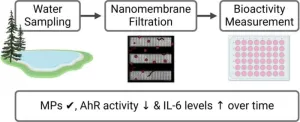(Press-News.org) The U.S. Food and Drug Administration (FDA) has granted accelerated approval for the immunotherapy afamitresgene autoleuecel (Tecelra®, also known as afami-cel) for the treatment of adults with a rare soft tissue cancer called synovial sarcoma.
Afami-cel is the first engineered T cell therapy to receive FDA approval for a solid tumor cancer.
The clinical trial that resulted in the drug’s approval was led by Memorial Sloan Kettering Cancer Center (MSK) sarcoma specialist and immunotherapy expert Sandra D’Angelo, MD.
“This treatment offers an important new option for people with this rare cancer,” Dr. D’Angelo says. “It is also an important step forward in the development of T cell therapies for solid tumors, which has been a major challenge.”
Other cell therapies, such as chimeric antigen receptor (CAR) T cell therapy, involve targeting surface proteins to recognize and attack a cancer cell. Until now, these types of immunotherapies have been used only to treat blood cancers.
Using Engineered Cell Therapies to Treat Solid Tumors
Synovial sarcoma is diagnosed in fewer than 1,000 people in the United States every year. A cancer that can develop in the extremities or in the soft tissue in the abdomen or lung, it most often occurs in young adults. It is slightly more common in men than in women.
“Sarcoma in general, and synovial sarcoma in particular, is a type of cancer where more treatments are desperately needed,” Dr. D’Angelo explains. “Once the disease spreads to other parts of the body, it is very difficult to control with the therapies we have now.”
T Cell Receptor Therapy Targets Solid Tumors
Afami-cel is an engineered cell therapy, similar to the CAR T treatments that have been approved for treating certain blood cancers since 2017. With cell therapies, a patient’s own T cells are collected from the blood and engineered in a lab to recognize cancer cells. They are then infused back into the bloodstream, allowing them to travel throughout the body to detect and destroy tumor cells.
Engineered cell therapies are often called “living drugs,” and for many people with blood cancer, they have offered the hope of a cure.
Afami-cel is not a CAR T therapy but is in a related category called T cell receptor (TCR) therapy. The T cells are engineered to carry an extra tool that allows them to recognize proteins, or markers, that are hiding inside cancer cells. By contrast, CAR T therapies can only see these cancer markers when they are on the outside of tumor cells.
“With both CAR T and TCR therapies, you are giving the immune cells the ability to fight the cancer,” Dr. D’Angelo explains. The cancer-causing protein that afami-cel targets is called MAGE-A4.
Another therapy that uses patients’ own immune cells, known as TIL therapy, also recently received FDA approval for treating the solid tumor melanoma. TIL therapy requires that immune cells be extracted from tumors that are surgically removed and then expanded in the lab before being infused back into the patient.
Results of Trial for Rare Soft Tissue Sarcomas
The phase 2 clinical trial that resulted in the drug’s approval was published in The Lancet in April 2024. Dr. D’Angelo was lead author of the paper, which reported that afami-celsignificantly shrank sarcoma tumors in more than one-third of patients.
“Some patients in the trial had their tumors completely disappear and have not had the cancer come back for several years,” Dr. D’Angelo says.
The clinical trial was an international study that treated a total of 52 people who had been diagnosed with synovial sarcoma and myxoid/round cell liposarcoma (MRCLS), another type of soft tissue sarcoma. These patients had not responded to other therapies.
Overall, almost 37% of patients saw their tumors shrink after receiving a single dose.
The drug helped about 39% of people with synovial sarcoma and 25% of those with MRCLS.
Patients with synovial sarcoma responded to this therapy for an average of 11.6 months, and those with MRCLS responded for an average of 4.2 months.
“These findings are significant for a group of patients who have largely exhausted other treatment options,” Dr. D’Angelo says.
Side Effects of Afami-Cel for Sarcoma
Before receiving the cell therapy afami-cel, patients were first treated with chemotherapy. The most frequent side effect of that treatment was low blood counts.
About 71% of patients in the trial also experienced cytokine release syndrome (CRS), a common reaction after cell therapies. This occurs when the immune system temporarily goes into overdrive to fight the cancer. For most patients in the afami-cel trial, this syndrome was not severe.
Dr. D’Angelo hopes that eventually afami-cel may work against any type of solid tumor that carries the mutated MAGE-A4 protein.
Afami-cel and other TCR therapies are also being studied in pediatric sarcomas.
This trial was funded by Adaptimmune.
Dr. D’Angelo has provided services to the following companies: Aadi Bioscience Inc., Adaptimmune, GI Innovation Inc., GlaxoSmithKline, Pfizer Inc., and Servier.
END
FDA approves engineered cell therapy for treating rare sarcoma
2024-08-02
ELSE PRESS RELEASES FROM THIS DATE:
Emory researchers help discover source of deadly fungal infections in bone marrow transplant patients, new study finds
2024-08-02
Emory researcher David Weiss has spent years studying a baffling phenomenon called heteroresistance, in which a tiny fraction of bacteria remain resistant to antibiotics, while the remainder succumb. Recently, he brought his scientific acumen to the equally deadly threat of fungal bloodstream infections in patients receiving bone marrow transplants. Bloodstream infections can be lethal in these patients, including infections from Candida parapsilosis, a species of fungi that can live in the digestive tract and occasionally make it into the bloodstream.
Weiss partnered ...
Brain activity associated with specific words is mirrored between speaker and listener during a conversation
2024-08-02
When two people interact, their brain activity becomes synchronized, but it was unclear until now to what extent this “brain-to-brain coupling” is due to linguistic information or other factors, such as body language or tone of voice. Researchers report August 2 in the journal Neuron that brain-to-brain coupling during conversation can be modeled by considering the words used during that conversation, and the context in which they are used.
“We can see linguistic content emerge word-by-word ...
Prescription fills for semaglutide products
2024-08-02
About The Study: The number of prescriptions filled for semaglutide has increased substantially, reaching 2.6 million prescriptions filled at retail pharmacies by December 2023. While Ozempic persistently accounted for most semaglutide fills, increases were considerably greater for Wegovy since its approval for weight loss in June 2021. These increases, which primarily occurred following increased awareness of weight-loss benefits in late 2022, are likely contributing to the FDA-reported shortage of Ozempic and Wegovy first issued in March 2022. Despite the disproportionate burden of obesity in Medicaid and Medicare Part D populations, and recent increases in public spending ...
Safety and risk assessment of no-prescription online semaglutide purchases
2024-08-02
About The Study: This qualitative study found that semaglutide products are actively being sold without prescription by illegal online pharmacies, with vendors shipping unregistered and falsified products. Two websites evaluated were sent FDA warning letters for unlawful sale of unapproved and misbranded semaglutide. U.S. poison centers have reported a 1500% increase in calls related to semaglutide, highlighting the need for enhanced pharmacovigilance including for online sourcing harms.
Corresponding Author: To contact the corresponding author, Tim K. Mackey, MAS, PhD, email tkmackey@ucsd.edu.
To ...
Glycated hemoglobin A1c time in range and dementia in older adults with diabetes
2024-08-02
About The Study: The findings of this study suggest that for older adults with diabetes, maintaining hemoglobin A1c (HbA1c) stability in individualized target ranges over time is associated with a lower risk of Alzheimer disease and related dementias. Lower HbA1c time in range may identify patients at increased risk of Alzheimer disease and related dementias.
Corresponding Author: To contact the corresponding author, Paul R. Conlin, MD, email paul.conlin@va.gov.
To access the embargoed study: Visit our For The Media website at this ...
Mast cells trap and use living neutrophils during allergic reactions
2024-08-02
Inflammation is the body's response to harmful stimuli, characterized by heat, pain, redness, swelling, and loss of tissue function. When balanced, inflammation protects the body by clearing harmful agents and initiating tissue repair. However, excessive inflammation can cause tissue destruction and disease. Key players in this process are various immune cells, which work together during inflammation. The type of immune cells involved often varies depending on the harmful stimulus, influencing the outcome of the inflammatory response.
Immune cell trapping during allergic responses
Mast cells, residing in tissues and critical for initiating ...
Exploding popularity of Ozempic and Wegovy among privately insured patients may worsen disparities
2024-08-02
A new USC study suggests that publicly insured individuals who are most likely to benefit from new drugs for diabetes and obesity are less likely to get them than those with private insurance.
Prescription fills for the drug best known as Ozempic or Wegovy — semaglutide — increased by more than 400% between January 2021 and December 2023, according to research out today in JAMA Health Forum.
Approved first for type 2 diabetes, then for weight loss, studies show that semaglutide also improves blood pressure and reduces cardiovascular disease — problems that plague millions of Americans. Yet the lion’s share of prescriptions ...
Sizing up microplastics: Nanofiltration uncovers environmental bioactivity
2024-08-02
A new study reveals the bioactivity of microplastics in Lake Ontario using cutting-edge nanomembrane filtering technology. Researchers found all samples contained microplastics ranging between 8 and 20 µm. The study highlights varying bioactivity levels, such as aryl hydrocarbon receptor (AhR) activity and IL-6 levels, indicating potential health risks. These findings underscore the urgent need for further research to comprehend the impact of microplastics on human health and the environment. This pioneering approach offers fresh insights into tackling the challenges posed by microplastic pollution.
Microplastics ...
What gave the first molecules their stability?
2024-08-02
The origins of life remain a major mystery. How were complex molecules able to form and remain intact for prolonged periods without disintegrating? A team at ORIGINS, a Munich-based Cluster of Excellence, has demonstrated a mechanism that could have enabled the first RNA molecules to stabilize in the primordial soup. When two RNA strands combine, their stability and lifespan increase significantly.
In all likelihood, life on Earth began in water, perhaps in a tide pool that was cut off from seawater at low tide but flooded by waves at high tide. Over billions of years, complex molecules like DNA, RNA and proteins ...
Cold antimatter for quantum state-resolved precision measurements
2024-08-02
Why does the universe contain matter and (virtually) no antimatter? The BASE international research collaboration at the European Organisation for Nuclear Research (CERN) in Geneva, headed by Professor Dr Stefan Ulmer from Heinrich Heine University Düsseldorf (HHU), has achieved an experimental breakthrough in this context. It can contribute to measuring the mass and magnetic moment of antiprotons more precisely than ever before – and thus identify possible matter-antimatter asymmetries. BASE has developed a trap, which can cool individual antiprotons much more rapidly ...




